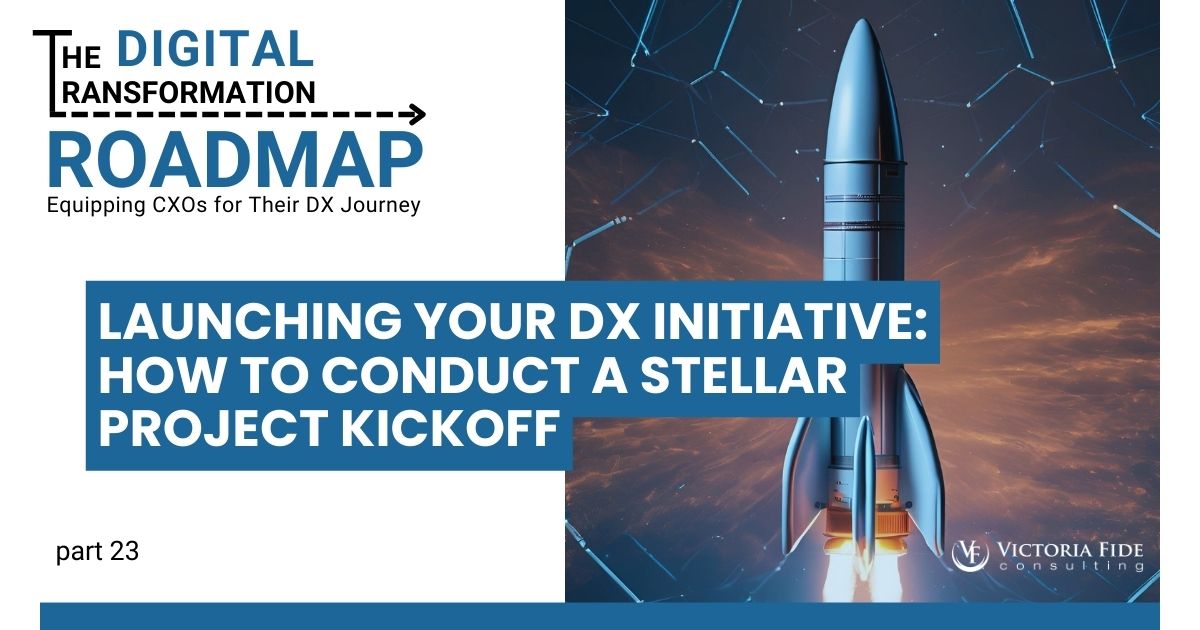
Launching Your DX Initiative: How to Conduct a Stellar Project Kickoff
The DX Roadmap series is produced by Victoria Fide Marketing with input and oversight from our leadership team and industry SMEs.
On Monday, July 8th, 2024, SpaceX launched Falcon 9 into space, which marked the company’s 370th mission. While significant planning and preparation goes into the rocket itself before blasting off, there is also considerable (and mostly unseen) preparation that goes into preparing the launch pad for launch day.
More than just a platform, the launch pad encompasses the metal launch mount, towers, cables, and even trenches under the platform to allow the exhaust to funnel away from the rocket, preventing it from being engulfed in flames. Without the proper foundation of the launch pad, no rocket would ever make it into space.
Just like there are months and years of work, preparation and testing before launching a rocket into space, launching a DX project doesn’t begin with a project kickoff event. At this stage of planning, this is only the beginning for most of the members of the project team, while CXOs, business owners and project managers have been in preparation mode for months to get the project to this point. However, that doesn’t make the kickoff (or launch) any less important. Understanding the importance of an effective kickoff meeting is essential. This article will guide you through the critical steps to ensure your digital transformation project reaches the stars.
Table of Contents
Building the Launch Pad: A Review of the Prepare Phase
Before we dive in, let’s take a moment to review the foundational work you’ve put into the project so far. As we move into the next phase of our DX journey – Execute the Change – you will hopefully begin to see the correlation between these essential activities and critical turning points within the project lifecycle. Here is a quick summary of the critical milestones within the Prepare Phase that will need to be built before the project launches. Think of these as elements of the rocket launch pad.
Understanding your organizational needs through assessments
From gaining a high level understanding of your organization’s as-is processes and technology infrastructure to understanding your organizational maturity or readiness for digital transformation, these assessments are crucial in bringing into focus your organizational needs. From there, your business objectives will clearly demonstrate how this initiative will be able to fill those needs.
Functional business objectives
The importance of having functional, clearly defined business objectives for the project cannot be overstated. While the seed for these objectives will have been planted from the very beginning stages with the Business & Technology Vision Meetings, they will continue to be refined and cultivated through the building of the project charter.
Project charter
The project charter is like the rudder of a ship, setting the course for the entire project and steering it towards a unified goal and the desired business benefits. The four essential pillars of a comprehensive project charter—goal, scope, approach, and roles & responsibilities—will continue to steer your project throughout every stage of the project execution.
Project team
More than just filling the seats on your project team, you will need to understand their strengths, weaknesses, and how to best leverage them both individually and as a unified team for the success of the project. This requires extensive assessments, interviews, and a change management strategy tailored to the unique needs of this project. Moreover, your chosen team will need to be adequately trained both in their project roles (which may differ from their day-to-day responsibilities) and any project tools that will be used.
Risks/barriers
Finally, a thorough picture of the risks and barriers that the project faces is necessary prior to launch. A comprehensive risk assessment combined with a 3-step mitigation process and ongoing monitoring will give you the edge when it comes to risk management. The more risk you can mitigate before project kickoff, the better your chances of success.
The Importance of a Project Kickoff Meeting
Now that you’ve built the foundation for a successful project launch, let’s take a look at why you should prioritize a Project Kickoff meeting.
1. Builds Excitement
A successful kickoff meeting sets the tone for the entire DX initiative. It can build excitement for the project and set the stage for positive change. When team members are enthusiastic, they are more likely to be engaged and committed to the project’s success. The project kickoff is the inception for creating a sense of community, camaraderie, and collaboration that will carry through the entire project.

Transformation is not easy, but it doesn’t have to be impossible. Take control of your project’s success today and schedule a free 30-minute consultation to find out how Victoria Fide can equip you for transformational success.
2. Builds Community
For many project team members, this may also be the first time they are meeting each other, as many initiatives are cross-functional. This is especially true when employing vendors or consultant team members. A project kickoff can provide a space for making new connections or deepening relationships with coworkers that are not used to working closely. This is also a time to introduce key team members that will have a direct impact on the project but may not be “in the weeds” so to speak. These may be sponsors, stakeholders, or steering committee (SteerCo) members.
3. Builds Alignment
And finally, an effective kickoff meeting can help set expectations for the project team, stakeholders, sponsors, steering committee, vendors, consultants and other interested parties. It provides an avenue for asking questions, clarifying roles and responsibilities, reviewing project objectives, and fostering open communication, ensure everyone is aligned and on the same page.
Essential Preparations for an Impactful Kickoff Meeting
Project Name: Naming your project can create a sense of identity and purpose. Choose a name that reflects the project’s goals and resonates with your team. For example, a construction company might choose “Foundation First Project” to emphasize the importance of a strong foundation both in constructing homes and in their own organization.
Project SWAG: Providing project-related merchandise, such as stress balls, t-shirts or banners, can help build a sense of culture and importance around the initiative. These items serve as constant reminders of the project’s goals and progress.
Company Lunch: Consider hosting a catered lunch or snack event to turn the kickoff into a memorable occasion. This not only boosts morale but also encourages informal interactions among team members.
Key Speakers: It is important to have several people presenting and speaking throughout the meeting. Enlist the project sponsor, CEO, or other high-level executive to provide an inspirational message to convey the project’s potential impact and incite enthusiasm. Include the project manager, other project leaders, and stakeholders to introduce key people that will be involved in driving the project forward.
Sample Agenda for the Kickoff Meeting: Countdown to Blast Off
10: Inspirational Message: The CEO, project sponsor or other executive opens with a speech to incite enthusiasm and convey the importance of this project.
9: Introductions: Present the project team members, steering committee, and sponsors
8: Project Overview: Outline the project’s objectives as identified in the Project Charter. Ensure everyone understands the project’s purpose and goals.
7: Project Scope: Discuss what is in scope and, equally importantly, what is not. This helps maintain focus and manage expectations.
6: Implementation Methodology: Provide an overview of the lifecycle of the project. Highlight key steps and the milestones needed for success.
5: Project Approach: Review key information in the Project Management Plan (PMP). This explains how the team will execute the project.
4: Project Timeline: Outline the timeline for each milestone and the planned go-live date. Ensure everyone understands the project schedule.
3: Risks and Assumptions: Discuss potential risks and the assumptions made during the planning phase. Transparency here is crucial for managing expectations and preparing for challenges.
2: Project Structure and Governance: Explain the project organization’s structure and governance, including how the steering committee will be utilized.
1: Next Steps: Detail what happens next as the project moves into the execution phase. Highlight the need for regular status meetings and ensure access to necessary technology systems.
Post-Kickoff Communication and Follow-Up Actions
After the kickoff meeting, the project sponsor, CEO, or other organizational leader should give a company-wide announcement to inform the rest of the organization that the project is about to launch. This announcement should include the What, Why, and How of the project. More importantly, it communicates to the organization that this project is a priority and that everyone’s support is needed for its success.
The kickoff meeting is only the first step in the project journey. Ongoing communication and engagement are essential to keep everyone aligned, motivated, and on track towards success. Regular status meetings, progress updates, risk assessments, and team building activities can all contribute to maintaining momentum throughout the project’s lifecycle. By prioritizing a successful kickoff meeting and continued engagement throughout, project teams can set themselves up for a successful and impactful outcome.

Conclusion: Securing a Successful Launch
Just as a rocket ship can’t blast off without a launch pad, project execution cannot commence without comprehensive preparation. From the very first stages of conceptualizing a DX initiative to building out a Project Charter and team, all of these preparatory activities culminate in the project kickoff.
This meeting is instrumental in setting a positive tone for the project, fostering community, and ensuring alignment around project scope, responsibilities, goals, and more. It sends a message from company leadership that this project is an organizational priority, and everyone will need to keep their eye on the ball to drive it forward.
As you begin planning your project kickoff meeting, remember that this event will set a positive tone that carries through the entire project lifecycle. Make sure to prepare adequately, prioritize an atmosphere of excitement, and provide ample opportunity for connection. With the proper foundation built, your project will be well-equipped to navigate challenges and achieve its strategic objectives. Set your sights high and begin the countdown—it’s time to shoot for the stars!
Subscribe to our weekly LinkedIn Digital Transformation Success newsletter and get notified of each new edition.
